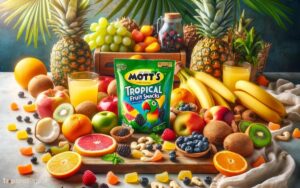How to Make a Pineapple Palm Tree Tropical Fruit Display?
To create a stunning Pineapple Palm Tree Tropical Fruit Display for your next event, follow these simple steps to construct the base with ripe pineapples and simulate the canopy with fresh palm leaves, then adorn with a selection of tropical fruits.
A Pineapple Palm Tree Tropical Fruit Display is an impressive centerpiece for any tropical-themed party or event.
To make one, you need:
The assembly process includes:
Transform your party table into a tropical paradise with this easy-to-create Pineapple Palm Tree display.
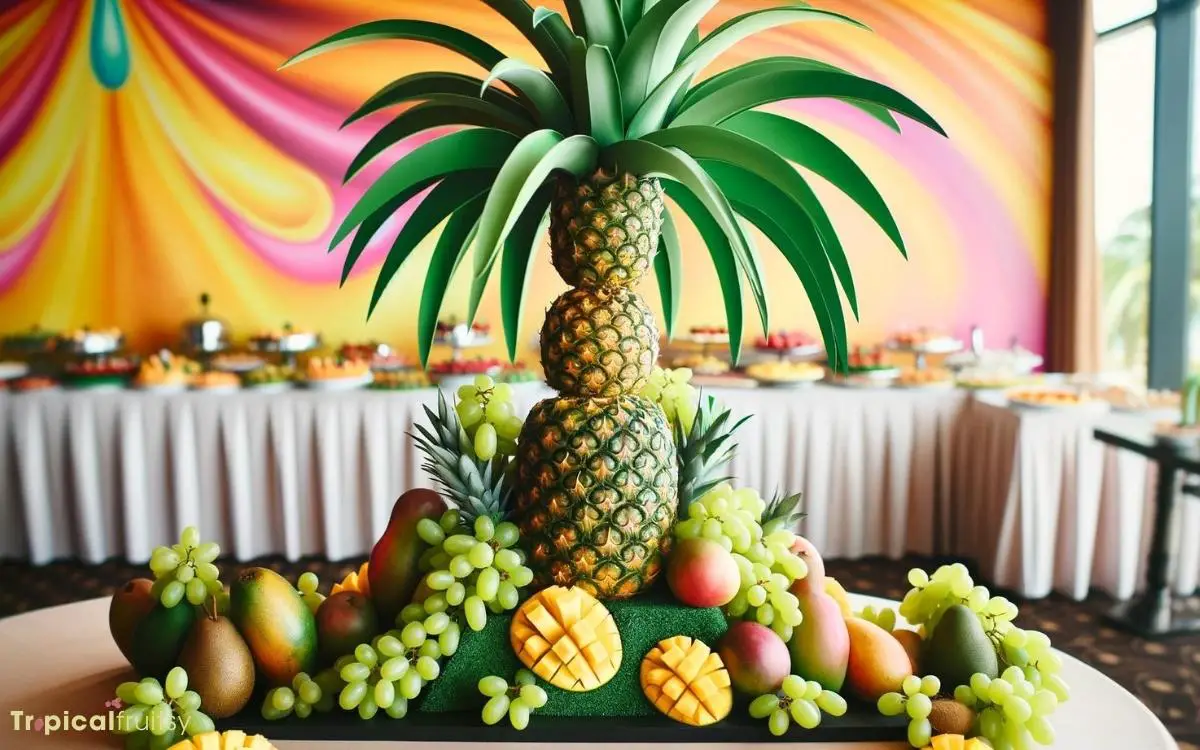
Key Takeaway
Gathering Your Materials
Before commencing the construction of your pineapple palm tree tropical fruit display, ensure you have procured all necessary materials.
This preparation phase calls for a meticulous selection of vibrant, ripe pineapples, their golden skins hinting at the tropical essence of your display.
Select firm, green kiwis and deep-hued berries to complement the dominant pineapple structure, combining texture and color to enchant the visual palate.
A sturdy base, such as a wooden cutting board, is essential for anchoring your edible sculpture. Bamboo skewers, of varying lengths, will act as the supporting framework, invisible yet vital.
Assemble a sharp knife, a melon baller, and a pair of heavy-duty scissors, tools that promise precision in crafting your fruity masterpiece.
With these materials at hand, the artistry of assembly awaits.
Step 1: Preparing the Pineapples
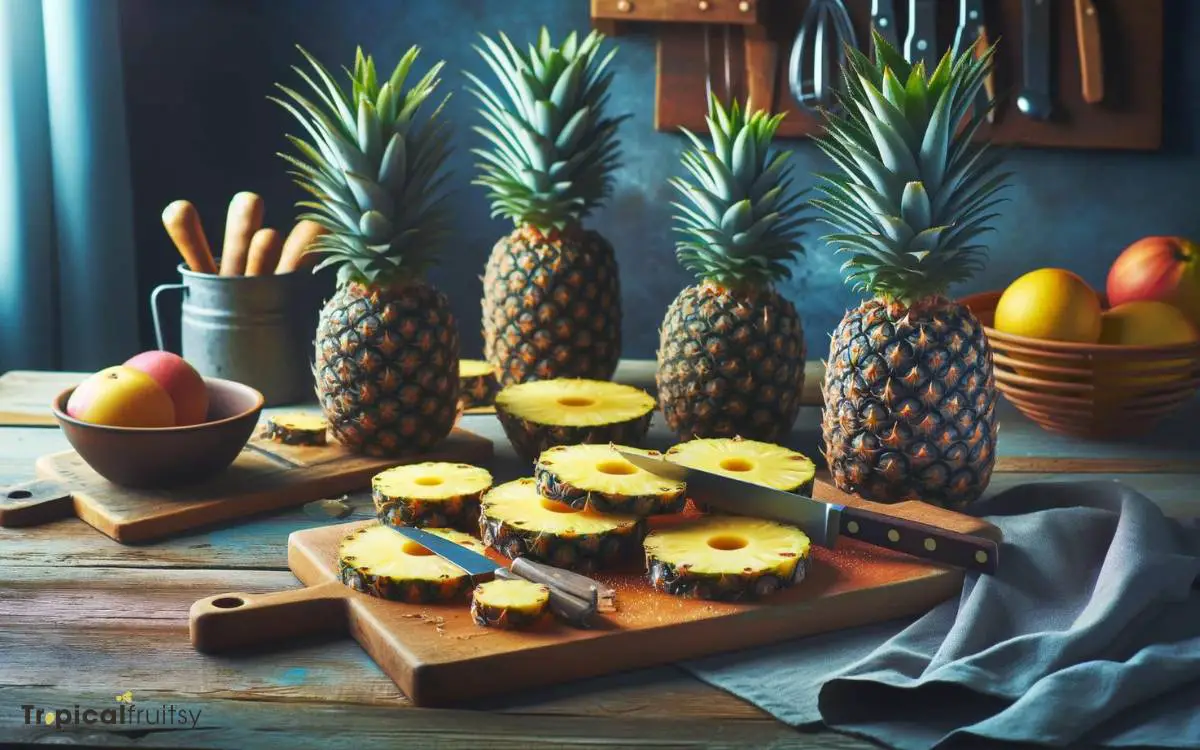
Commence by selecting three medium-sized pineapples that will form the tiers of your tropical palm tree display.
Seek out fruits with vibrant, green leaves and firm, golden-brown exteriors—these will exhibit the most aesthetic appeal and structural integrity for your creation.
With a sharp serrated knife, meticulously trim away the rough outer skin, ensuring to carve out any brown eyes, which are the rough spots on the pineapple’s surface.
As you sculpt each pineapple, retain the crowning rosette of leaves intact, for these will mimic the palm fronds in your tropical tableau.
Slice the base of each pineapple to create a flat, stable platform that will rest securely as you stack them.
Finally, remove the core from the upper two pineapples to facilitate a seamless vertical assembly, leaving the bottom pineapple whole to anchor your edible arrangement.
Step 2: Assembling the Base
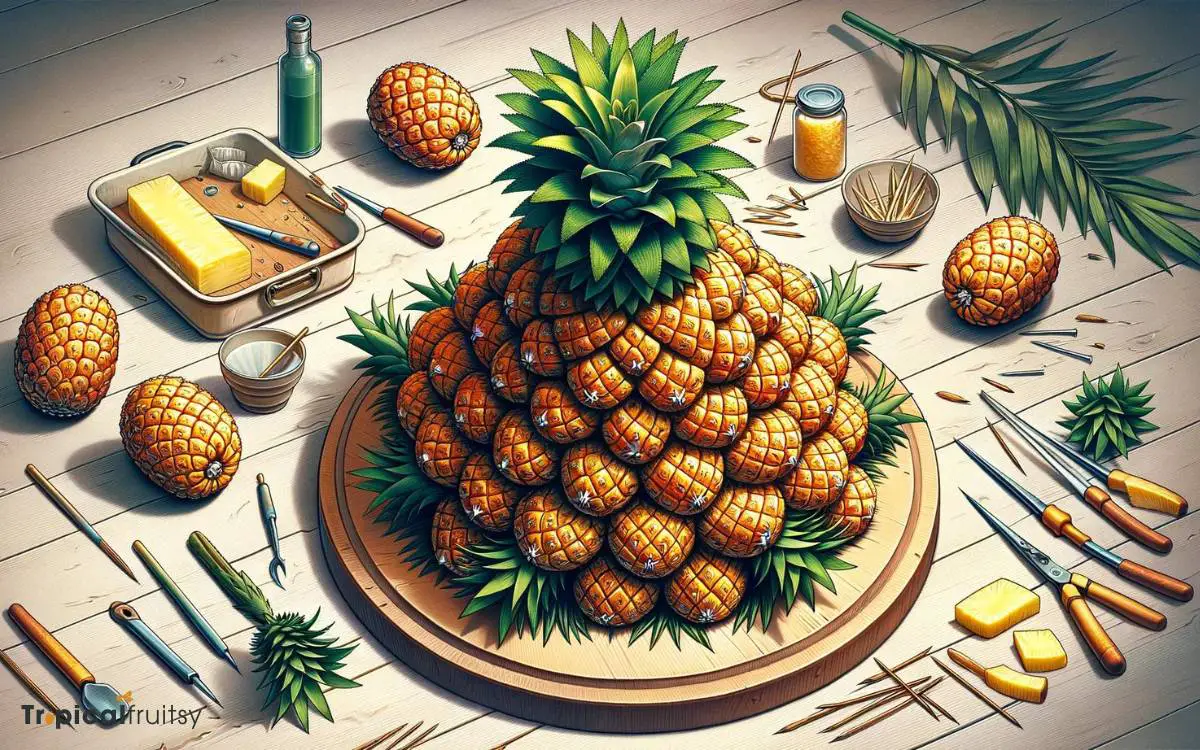
Transitioning to the construction of the display, secure a sturdy base plate or platter to anchor the lowest pineapple and ensure the stability of your tropical fruit display.
The foundation is not merely functional; it’s the bedrock upon which the exotic structure will rise, a tableau of verdant fronds and golden hues.
- Choose a Base Plate: Opt for a heavy ceramic or stone platter that can withstand the weight of multiple pineapples and additional fruit.
- Non-Slip Surface: Consider lining the platter with a non-slip mat or damp cloth to prevent any untoward shifts or slides.
- Central Positioning: Align the first pineapple dead center on the base, ensuring it stands upright and true.
- Test Stability: Gently press down on the pineapple to affirm its steadfastness. If it wobbles, realign until achieving a steadfast poise.
Step 3: Attaching the Palm Leaves
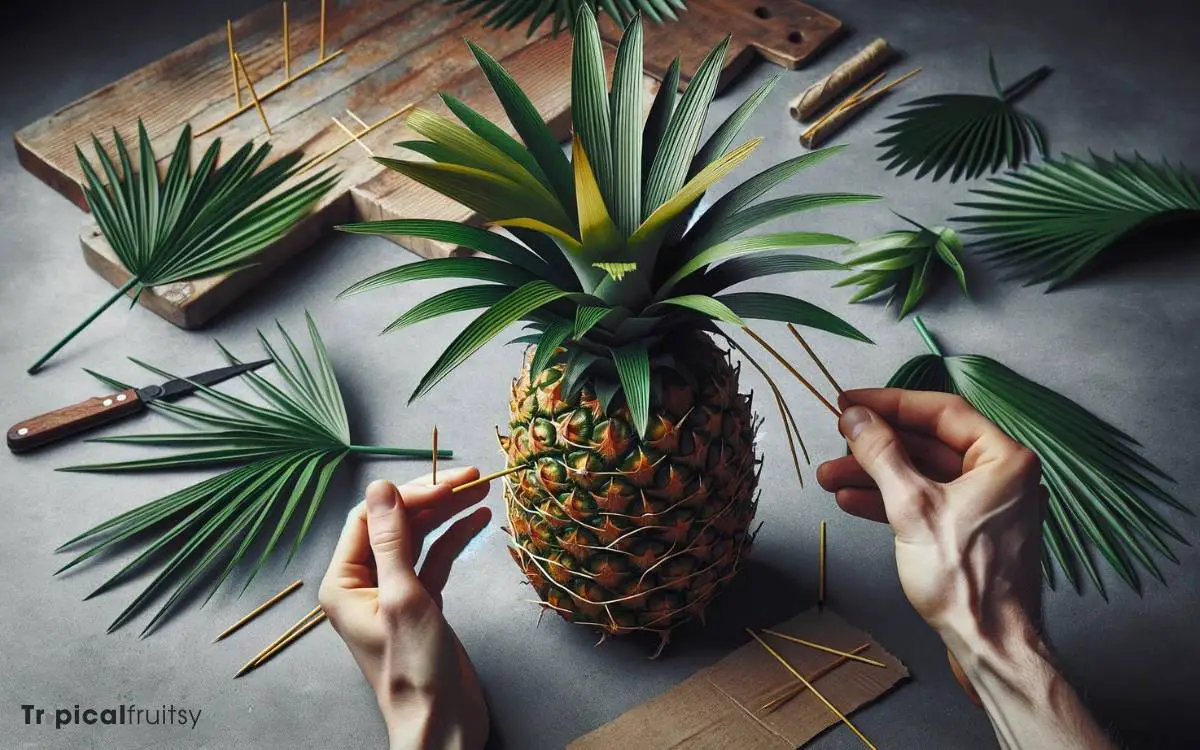
Transitioning to the pinnacle of our tropical centerpiece, the art of affixing the palm leaves requires both finesse and stability.
Selecting robust foliage capable of withstanding the duration of the event is paramount, ensuring that the verdant canopy remains resplendent and intact.
Mastery of secure attachment techniques is crucial, as it provides the structural integrity necessary to evoke the exotic allure of a true palm tree.
Leaf Attachment Techniques
Attaching the palm leaves to the pineapple requires a secure method to ensure they remain upright and give the desired tropical effect.
The technique involves a series of steps that must be performed with meticulous care and an eye for aesthetic detail.
Here is a concise guide:
- Select Robust Leaves: Choose palm leaves that are sturdy yet pliable, ensuring they can withstand attachment without wilting.
- Trim the Stems: Cut the leaf stems at an angle to facilitate easier insertion into the pineapple crown.
- Insert Securely: Gently push the stem into the pineapple, ensuring a snug fit that prevents the leaf from drooping.
- Check Angles: Arrange the leaves to fan outwards in a natural and visually appealing manner.
As each leaf finds its place, the next important phase is ‘securing leaves safely’ to maintain the integrity of the display.
Securing Leaves Safely
To ensure the palm leaves remain affixed throughout the duration of your event, it is imperative to employ reliable securing methods.
Begin by selecting robust, yet flexible, materials for attachment such as floral wire, zip ties, or sturdy twine. These should be both inconspicuous and strong enough to maintain the artistic integrity of your tropical display.
Carefully thread your chosen securing material through the base of the palm leaves, where the spine is thickest, to provide a stable anchor point.
Fasten the leaves around the apex of your pineapple structure with meticulous precision, ensuring that each leaf is snugly attached while preserving its natural, graceful curvature.
This delicate balance of security and aesthetics will ensure that your palm tree stands tall and vibrant, inviting guests to bask in its tropical splendor.
Choosing Durable Foliage
While selecting foliage for the pineapple palm tree, opt for leaves that are not only aesthetically pleasing but also possess the resilience to withstand the duration of your display without wilting or fading.
The foliage should complement the tropical theme with a verdant flourish, bringing to life the illusion of an exotic palm.
To ensure your pineapple palm tree remains the centerpiece of your tropical tableau, consider the following:
- Artificial Palm Leaves: These provide a permanent solution, impervious to the elements and time.
- Hardy Leaf Varieties: Choose plants like magnolia or holly, which retain their shape and color.
- Pre-Treatment: Mist leaves with water and refrigerate them before the event to maximize freshness.
- Attaching Mechanism: Use floral wire or zip ties to affix leaves securely, maintaining an organic and seamless appearance.
Step 4: Arranging Additional Fruit
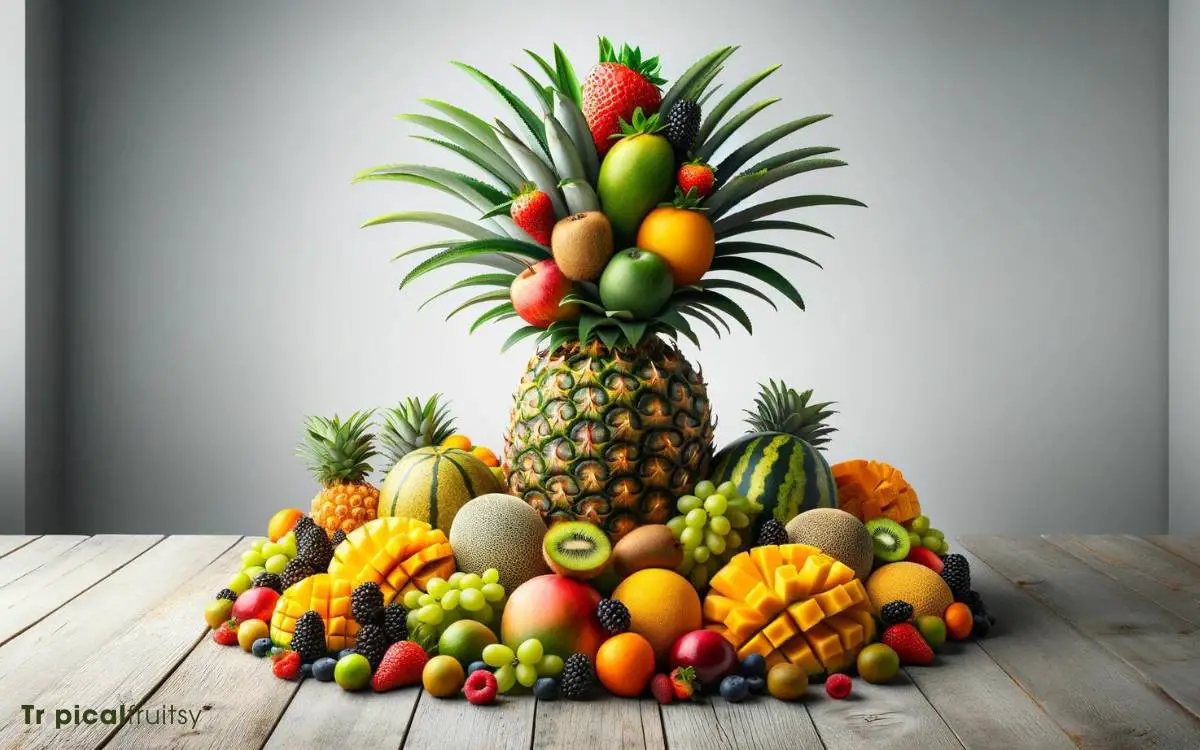
As the pineapple palm tree begins to take shape, the selection of complementary fruits becomes pivotal in enhancing the tropical allure of the display.
Mastering colorful arrangement techniques not only captivates the eye but also accentuates the lushness of the exotic tableau.
Ensuring each piece of fruit is securely positioned is the final, critical step to guarantee the integrity and the aesthetic harmony of the finished masterpiece.
Selecting Complementary Fruits
Arranging a variety of colorful, complementary fruits around your pineapple palm tree will enhance the tropical theme and add visual interest to the display.
When selecting fruits, consider not only their flavors but also their textures and hues. An opulent spread of fruits can transform a simple display into a cornucopia of tropical abundance, creating a feast for the senses.
- Mangoes: Select ripe yet firm mangoes with a vibrant orange flesh, to introduce a rich, sweet flavor and a splash of sunset hues.
- Kiwi: Slice kiwi into rounds or half-moons to add a bright green color and a tangy taste that contrasts beautifully with the sweetness of other fruits.
- Berries: Incorporate a variety of berries — strawberries for their lush red, blueberries for their deep blue, and raspberries for their jewel-like appearance — to introduce a burst of color and diverse textures.
- Citrus Fruits: Segment oranges, grapefruits, and tangerines for a juicy, refreshing element that complements the tropical profile and adds a spectrum of warm colors to the arrangement.
Colorful Arrangement Techniques
Building on the selection of complementary fruits, masterful arrangement techniques are essential for creating a visually stunning tropical fruit display that captivates and delights the senses.
The artistry lies not only in the selection of vibrant fruits but also in their strategic placement.
To accentuate the lush green of the pineapple palm, consider the following schema of color contrasts and textural juxtapositions:
| Color Palette | Texture | Fruit Examples |
|---|---|---|
| Deep Reds | Smooth | Strawberries, Cherries |
| Bright Oranges | Juicy Segments | Oranges, Mangoes |
| Rich Purples | Firm Berries | Grapes, Blackberries |
| Sunny Yellows | Creamy Flesh | Bananas, Starfruits |
Incorporate these elements by creating clusters that radiate from the base, leading the eye upwards to the apex of the pineapple palm, thus ensuring a harmonious and immersive tropical experience.
Securing Fruit Placement
Frequently, the stability and aesthetic appeal of a tropical fruit display hinge on the meticulous securing of additional fruits to the pineapple palm structure.
Each piece must be carefully placed to ensure the entire arrangement maintains its intended form and captivates onlookers with its lush, vibrant allure.
To achieve this, consider the following steps:
- Choose Complementary Fruits: Select fruits that not only match in color but also in size for symmetry and balance.
- Slice for Stability: Cut flat bases for fruits to sit securely on the display surface.
- Skewer for Structure: Use wooden skewers to attach smaller fruits around the pineapple base firmly.
- Layer for Luxuriance: Strategically layer fruits to create a full, abundant look, ensuring each piece supports the next.
Step 5: Final Touches and Presentation
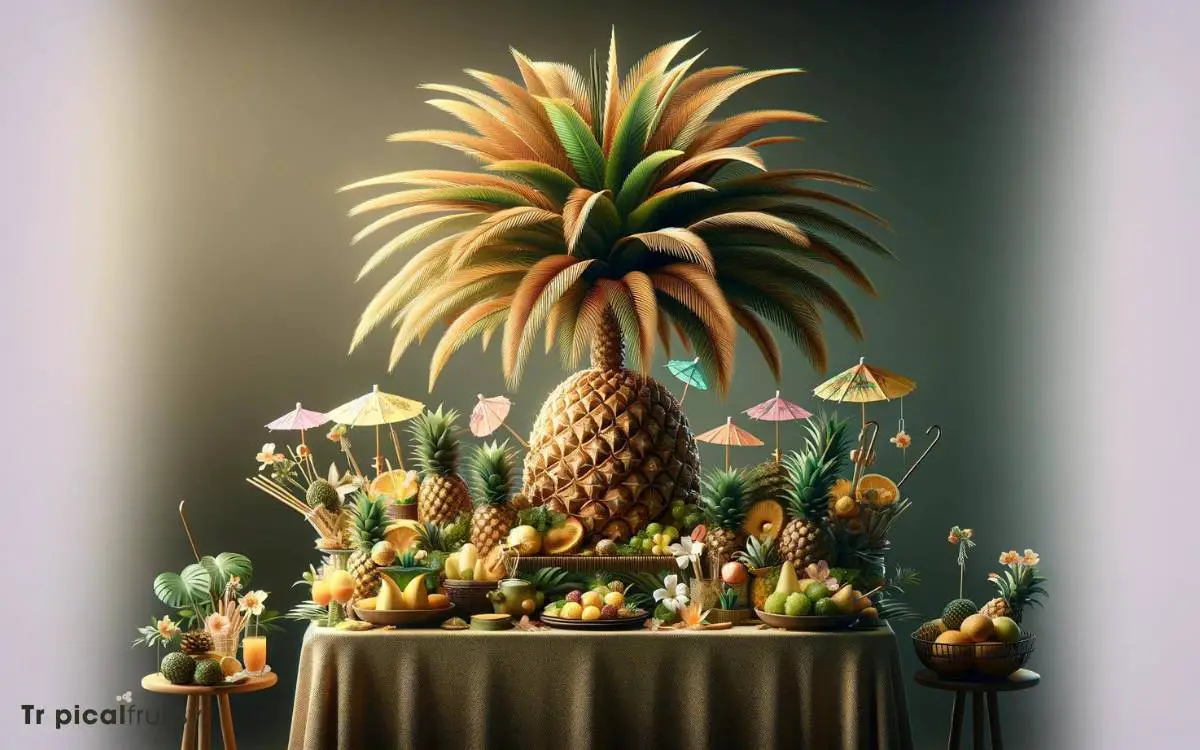
Once your pineapple palm tree structure is assembled, focus on enhancing its visual appeal with strategic placement of additional tropical fruits and decorative elements.
Adorn the base with a lush ring of vibrant kiwis, mango slices, and coiled orange peels. Intersperse these with clusters of deep red grapes and the bright hues of dragon fruit to create a compelling color palette that beckons the eye.
For a touch of whimsy, tuck small umbrellas into the fruit or weave a thin garland of flowers between the offerings.
Ensure that the display is not only a feast for the taste buds but also for the eyes, merging the exotic with the familiar in a dance of textures, shapes, and colors that captures the essence of tropical abundance.
Can Bananas Be Used in a Pineapple Palm Tree Tropical Fruit Display?
Yes, bananas are tropical fruit which means they can definitely be used in a pineapple palm tree tropical fruit display. Just imagine the vibrant colors and delicious flavors of both fruits combined to create a stunning centerpiece for any tropical-themed event or party.
Maintenance and Serving Tips
To ensure longevity, proper refrigeration of the pineapple palm tree display is paramount for preserving freshness prior to serving.
The vibrant hues and crisp textures of your tropical masterpiece can be impeccably maintained with meticulous care.
When it comes to maintenance and serving, consider the following guidelines:
- Chill the display in a refrigerator large enough to accommodate its size, ideally keeping it at a temperature just above freezing to prevent frost damage.
- Assemble the display close to the event time to minimize the duration it needs to be stored.
- Cover the fruit gently with a cling film to protect it from absorbing any odors within the refrigerator.
- Prior to presentation, allow the display to sit at room temperature for approximately 15 minutes to enhance the flavors and ensure the fruits are not too chilled for guests’ enjoyment.
Employ these strategies to ensure your edible sculpture remains a luscious focal point of the celebration.
Conclusion
The creation of a pineapple palm tree tropical fruit display is a symphony of meticulous preparation and artful assembly.
Each element, from the robust base to the verdant palm leaves, harmoniously contributes to an aesthetic feast as appealing to the eye as it is to the palate.
When the final piece is placed, this culinary sculpture stands as a testament to the concept that we eat with our eyes first, inviting guests to partake in its tropical bounty.




